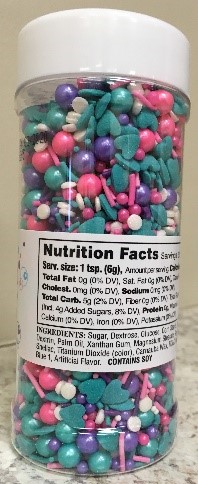 |
|
Cottage Food Connection
Enews for Minnesota Cottage Food Producers
|

WHAT'S NEW?
Registration Cards Have a New Look

The 2019 Minnesota Registered Cottage Food Producer card has a new look (pickle jar) and size (8.5X11). The 2019 identifier is a pickle jar on the front panel. (The plan is to
have three i
dentifiers and rotate each year.) On the back panel is the registrants name, address, registration number, expiration date etc. The Minnesota state seal verifies it is an official registration. The list of requirements are also included.
Registered Cottage Food Producers card reminders:
- Carry the original with you. It's optional to display it. However, it needs to be in your possession at the point of sale.
- The original serves as the official registration. You can laminate the original to protect it.
- You may copy the registration card to keep a copy in your files; however, these copies do not serve as the official registration.
- Do not cut or manipulate the registration card.
- If lost or damaged, contact MDA to get a registration re-printed by emailing [email protected] or calling 651-201-6062.
If you move from Tier 1 to Tier 2 in the middle of the year, proactively move into tier 2 by re-registering.
Product list updated
The Minnesota Farmers' Market Association keeps and updates the Non-potentially hazardous food list. The list highlights food and beverages allowed or not allowed as cottage food products. Check out the updated list dated February 26, 2019 at https://www.mfma.org/.
|

|


Decorating with glitter? Is it edible?
Decorating with glitters, powders and dust is a popular way

to add some sparkle to cakes, cookies and cake pops. Some
products promoted for food decorating contain non-edible or t
oxic
ingredients and have caused illnesses. Therefore, the Minnesota Department of Agricul
ture advises bakers to
avoid use of non-edible decorative products
(December 20, 2018).
When choosing decorations:
- Read labels. If it is edible, a list of ingredients is required.
- Look for "edible" on the label.

- Non-toxic does not mean edible.
- Don't use products labeled "for decorative purposes only".
- If the product does not have an ingredients list, don't use it.
- If you use non-edible decorations or toppers, tell your customers to remove before eating.
- Create your own glitter using gelatin and edible luster dusts or powdered food colors.
|


Don't touch my food please
Disease causing microbes on hands transfer easily because they don't stick to the skin as well as human resident microbes. Therefore, while preparing or packaging ready-to-eat cottage food product, it is critical to prevent contamination from hands.
Prevent contamination from hands to food by using single-use gloves, utensils or nonabsorbent single use aids such as parchment or wax paper. Why? Depending on the level of contamination, handwashing alone may not be enough to prevent the transfer of disease-causing organisms. So please, don't touch ready-to-eat food with your bare hands.
Photo: Karen Peterson, Confections by Karen, used with permission.
|


Can I use natural or green sanitizers to sanitize food contact surfaces?
Dr. Annie, a microbiologist, did independent testing on over 50 household cleaning products to answer this question. She tested products, including Thieves by Young Living and Sol-U Guard by Melaleuca, for their effectiveness against Norovirus. See the results here.
Heat or chemicals are two valid methods to sanitize food contact surfaces effectively. Ohio State University has information on using inexpensive household food-safe products like chlorine bleach, vinegar and hydrogen peroxide to sanitize. View here.
When choosing a sanitizing product for your cottage food kitchen look for:

- A label stating designed for food contact surfaces.
- Label stating a reduction in microorganisms to 99.999% within 30 seconds.
- Unscented, fragrance-free products (Most scents and fragrances are not food-grade).
- Products certified by third party organizations like Green Seal, EcoLogo or Design for the Environment. See list here.
- EPA-assigned establishment number, as opposed to an EPA registration number, required for a products or technologies making a microbiological-kill claim.
|


PRODUCER SPOTLIGHT
Corrine Bonnema
The "Pie Lady"
In 2018, Corrine Bonnema, the "Pie Lady", sold 525 pies at the Luverne, Minnesota and Rock Rapids, Iowa Famers' Markets. She uses the fruit she grows to specialize in fruit pies. After getting bored just making plain cherry, apple and raspberry pies, Corrine experimented combining different fruits. The first big seller was strawberry-rhubarb pie, then triple berry pie. In the fall, her pear/apple pie is a favorite customer request. Her favorite concoction is Bumbleberry pie - a combination of apple, raspberry, blueberry, strawberry and rhubarb.
The "Pie Lady" is well known in her community. Pies have been served and enjoyed throughout Luverene. She's made apple pies for a friend's mother's funeral, cherry pies for a groom's dinner, an assortment of pies for a reception, and pies for a graduation party.
Corrine shares this pie baking tip: Use Instant Clear Jel® to thicken the juices in pies. "It takes a little practice on how much to use for your thickener, but it's a wonderful product," suggests Corrine.
|
Christine Walker
Christine Walker is just getting started with her cottage food business. After 20 years of saying, "I should do this as a business" she took the plunge. She loves baking, so she started off selling cakes, cupcakes, cookies, bars, fudge and pies. Pound cakes, cakes, butter cookies and peanut butter cookie blossoms are the top sellers.
To keep her cottage food safe, Christine maintains a clean production area, practices safe food handling and pays attention to time and temperatures of ingredients.
Christine knows she made the right decision to go into t
he cottage food business. Hearing how much her customers' loved
the

product and ordering more product is evidence that this new food entrepreneur is on the right track.
Christine's dream is to turn her passion into a full-time business. She hopes to expand beyond cottage foods by becoming licensed to offer full meal options.
|

University of Minnesota Extension Food Entrepreneurs Website
The University of Minnesota Extension Food Entrepreneurs
website
is your one stop shop to find
a list of handy resources, how to safely offer food product samples, register for classes and link to the cottage food Q & A blog.
Cottage food law guidance
The Minnesota Department of Agriculture's Cottage
Food Law Guidance website is updated often to answer frequently asked questions about the Minnesota Cottage Food Law.
|
Interested in being featured in the Producer Spotlight? Have a favorite resource to share? Curious about something? Let me know at
[email protected]
or
[email protected]
.
|
|
© 2019 Regents of the University of Minnesota. All rights reserved. University of Minnesota Extension is an equal opportunity educator and employer. In accordance with the Americans with Disabilities Act, this material is available in alternative formats upon request. Direct requests to 612-624-0772.
|
|
|
|
 |
|